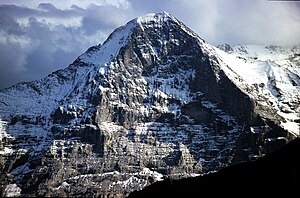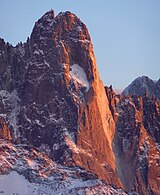Great north faces of the Alps
 From Wikipedia - Reading time: 5 min
From Wikipedia - Reading time: 5 min
You can help expand this article with text translated from the corresponding article in German. (July 2012) Click [show] for important translation instructions.
|

The six great north faces of the Alps are a group of vertical faces in the Swiss, French, and Italian Alps known in mountaineering for their difficulty, danger, and great height. The "Trilogy" is the three hardest of these north faces, being the Eiger, the Grandes Jorasses, and the Matterhorn.
List
[edit]The six great north faces are (sorted by the date of the first ascent of the north face):
- Matterhorn, first ascent in August 1931;
- Cima Grande di Lavaredo, first ascent in 1933;
- Petit Dru, first ascent in 1935;
- Piz Badile, first ascent July 1937;
- Eiger, first ascent in July 1938;
- Grandes Jorasses, first ascent in August 1938.
Trilogy
[edit]Three of the six great north faces — the Eiger, the Matterhorn, and the Grandes Jorasses – are considered by climbers to be much harder to climb and are known as 'the Trilogy' (or the "North Face trilogy").
Milestones and records
[edit]- The first climber to have ascended all six north faces was Gaston Rébuffat, a French alpinist and mountain guide, who chronicled his feat in his 1954 work, Etoiles et Tempêtes (Starlight and Storm).[1]
- The first climber to ascend all six north faces in a single year was the Austrian Leo Schlömmer, from the summer of 1961 to the summer of 1962.
- Ivano Ghirardini was the first person to climb the "Trilogy" in winter, solo (1977–78), and Catherine Destivelle was the first woman (1992-93-94) to complete the solo winter trilogy.[2]
- With the introduction of the concept of enchainment, the next challenge was to climb all three faces in one outing, a race eventually won by Tomo Česen in 1986 at the age of 26, although nobody witnessed his feat;[3] after that Christophe Profit, who achieved the feat between 11–12 March 1987 in a time of 24 hours.[3]
- From December 2014 to March 2015, during a project known as "Starlight and Storms", Tom Ballard climbed these six north faces solo, being the first person to complete this feat in a single winter season without a support team.[4] A film chronicling this project, Tom, won several awards at international film festivals.[5][6]
- On 15 August 2021, with his ascent of the Petit Dru in 1 hour 43 minutes, the Swiss climber Dani Arnold completed a ten-year project to make the fastest solo speed climb of all six faces. He had previously set speed records on the other five faces, with Ueli Steck's 2015 solo of the Eiger north face the only current faster ascent (when Arnold climbed the Eiger north face in 2011 in two hours and 28 minutes it was the fastest at that date).[7][8]
Gallery
[edit]-
The north face of the Eiger
-
The north faces of the Grandes Jorasses
-
The north face of the Matterhorn
-
The north-east face of Piz Badile
-
The north face of the Petit Dru
-
The north face of Cima Grande di Lavaredo
Bibliography
[edit]- Anker, Daniel (ed.) (2000) Eiger: The Vertical Arena. Seattle: The Mountaineers.
- Bonatti, Walter (2001). The Mountains of My Life. New York: Modern Library. ISBN 0-375-75640-X.
- Hargreaves, Alison (1995). A Hard Day's Summer: Six Classic North Faces Solo. London: Hodder & Stoughton. ISBN 0-340-60602-9
- Rébuffat, Gaston (1999). Starlight and Storm: The Conquest of the Great North Faces of the Alps. New York: Modern Library. ISBN 0-375-75506-3
- Destivelle, Catherine (2003). Ascensions, Arthaud (French) (ISBN 2-7003-9594-8)
- Destivelle, Catherine (2015). Rock Queen, Hayloft Publishing Ltd (ISBN 978-1910237076)
References
[edit]- ^ Rébuffat, Gaston (1999). Starlight and Storm: The Conquest of the Great North Faces of the Alps. New York: Modern Library. ISBN 0-375-75506-3.
- ^ Destivelle, Catherine (2003). "L'Eiger en solitaire et en hiver". Ascensions. Arthaud. p. 181. ISBN 2-7003-9594-8.
- ^ a b Twight, Mark (2001). "My Way: A Short Talk with Tomo Cesen". Kiss Or Kill: Confessions of a Serial Climber. Mountaineering Books. p. 63-74. ISBN 978-0898867633. Retrieved 10 January 2023.
- ^ Sawer, Patrick (26 February 2016). "Tom Ballard conquers the Alps 20 years after his mother's death on K2". The Telegraph. ISSN 0307-1235. Retrieved 3 March 2019.
- ^ ""Tom": il film sull'alpinista Ballard conquista i film festival internazionali della montagna". Fassa.com. 14 January 2016. Archived from the original on 6 March 2019. Retrieved 27 April 2019.
- ^ Elena Golatelli. Tom.
- ^ Clarke, Owen (29 September 2021). "Dani Arnold Completes Speed Solos of all Six Great North Faces of the Alps". Climbing.com. Retrieved 2 October 2021.
- ^ Douglas, Ed (17 June 2021). "Speed Soloing Is Climbing's Deadliest Game—It Has One Living Player". Climbing. Retrieved 4 October 2023.
Licensed under CC BY-SA 3.0 | Source: https://en.wikipedia.org/wiki/Great_north_faces_of_the_Alps1 views | ↧ Download as ZWI file
 KSF
KSF




